Owning a yard comes with the annoying reality of weeds. Even though you might think you’re taking good care of the grass, it will still come up. Not to add, weeds tend to grow more quickly than you can keep up with them. If it helps, you’re not the only homeowner in with weeds in Texas who has to deal with grass weeds. If you live in Texas, there is one thing we can all agree on: weeds are a pain, just like they are everywhere else in the nation.
Maintaining a beautiful lawn in Houston, Texas, and the surrounding environs can be challenging. Due to the vulnerability of lawns caused by dry, hot summers and severe winters, weeds can easily take over your landscapes. Learning the state’s common weeds, broken down into three groups: broadleaf weeds, sedges, and grass-like weeds, will help you better understand how to keep your grass free of weeds. Below, we will list the most common types of weeds that grow in Texas and how to identify them.
16 Weeds That Grow in Texas
1. Dandelions
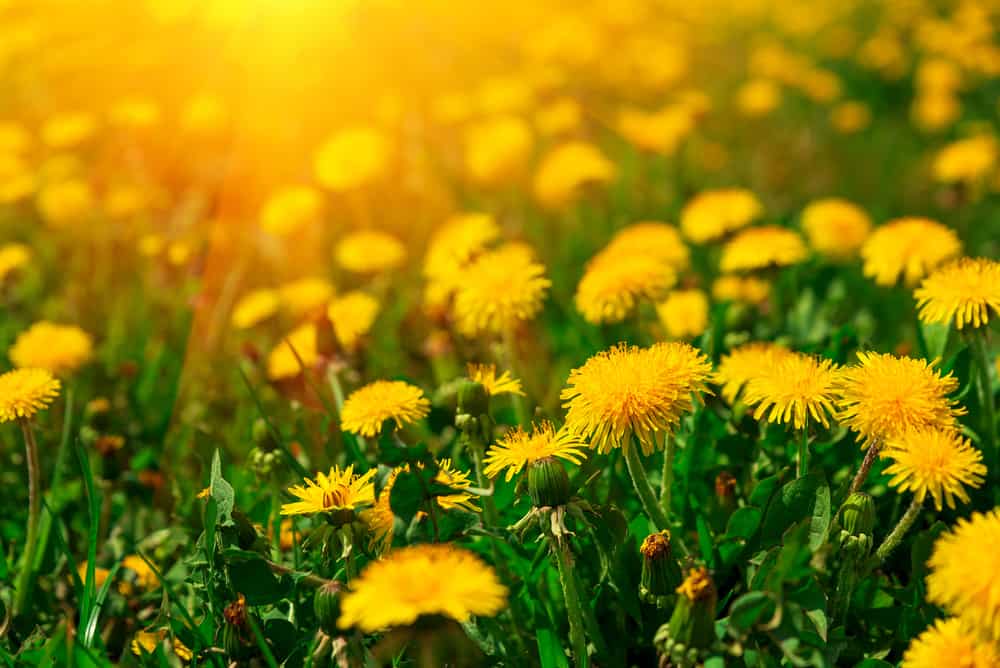
Dandelions have long, bright yellow flowers with “puffball” seed bearers.
©Tetiana Shumbasova/Shutterstock.com
Except in desert areas, dandelion is a common perennial broadleaf weed in Texas that can be found at elevations up to roughly 11,000 feet. It is a typical weed of mountain meadows and grass and consists of a complex of biotypes that vary with environmental variables. Although dandelions might not grow in the yard where you want them to, they have a variety of purposes, from providing pollinators with early food to serving as all-natural medicines. Dandelions are well-known and common, so it’s easy to identify them, especially with their long, bright yellow flowers with “puffball” seed bearers.
2. Crabgrass

With a scientific name derived from the Latin word “digitus,” which means “finger,” crabgrass is known for its long, finger-like florets.
©iStock.com/Yesim Sahin
Because it grows tenaciously in hot, dry circumstances, crabgrass are common weeds in Texas, and the surrounding areas. Preventing this weed from producing seeds will help control its spread and keep it from returning to your lawn yearly. With a scientific name derived from the Latin word “digitus,” which means “finger,” crabgrass is known for its long, finger-like florets. Although they can also be found in subtropical, tropical, and colder temperate climates, these weeds are native to tropical and warm temperate environments.
3. Nutsedge
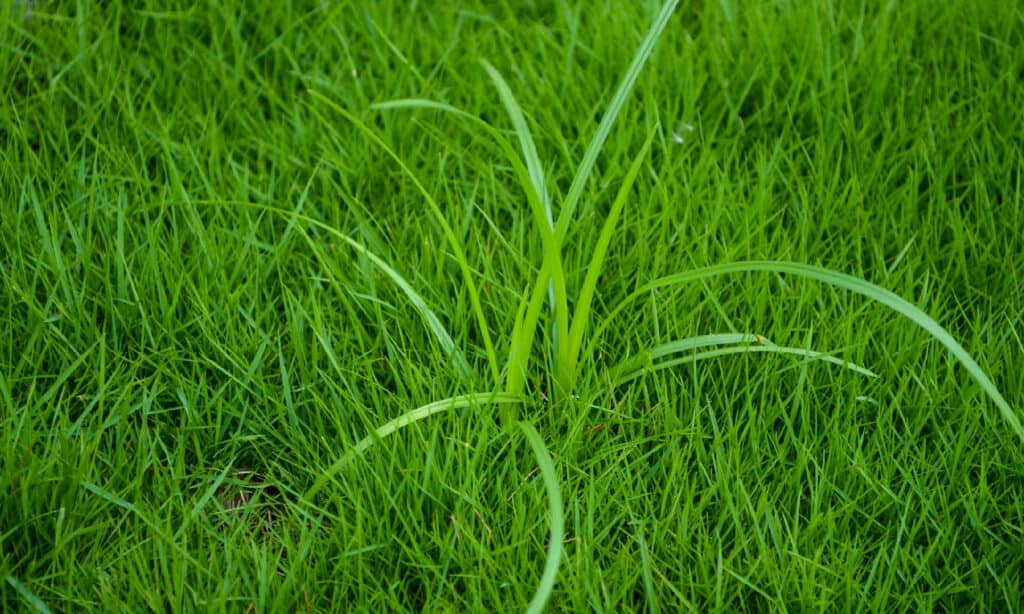
Nutsedges can be identified by leaves that have a V-shaped side aspect.
©iStock.com/Bhupinder Bagga
Another typical Texas weed that is challenging to control owing to multiple tubers in each plant is nutsedge. Pulling it will result in the activation of latent tubers, which will increase the number of plants. These grass sprouts can be identified by leaves that have a V-shaped side aspect. The majority of sedges can be controlled by routine mowing that removes seed heads and stops growth. If you notice sedges on your lawn, try to reduce the water you use or the frequency of watering them.
4. Bluegrass
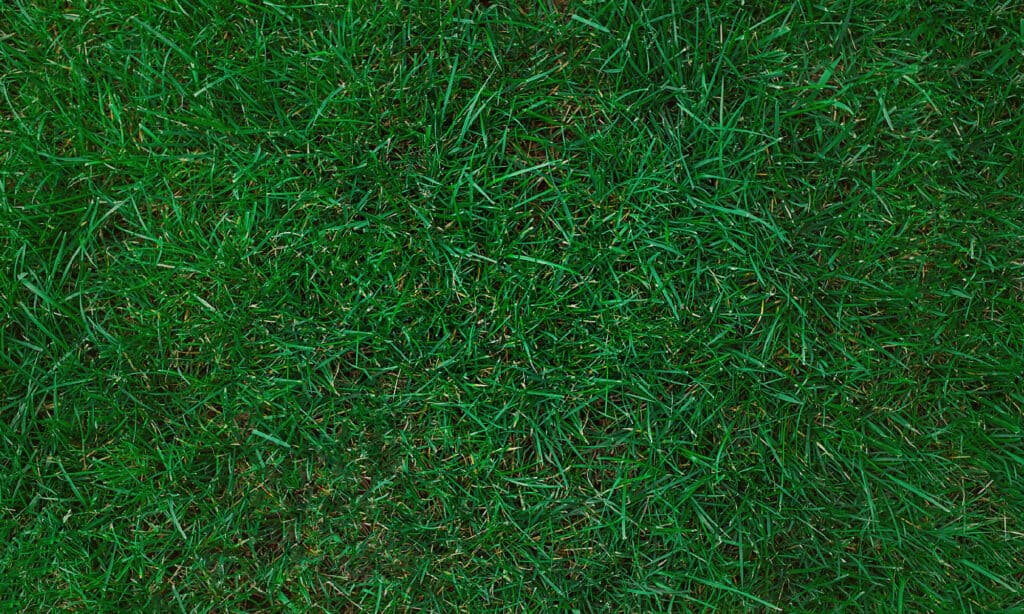
The second most prevalent weed in Texas is bluegrass.
©iStock.com/KacieBuccieri
Because of its resilience during the summer, bluegrass, or Poa annua, is the second-most prevalent weed in Texas. Although the “fingers” are thicker and the seeds are dark brown to black, the seed pods mostly resemble crabgrass. To eradicate these weeds, pre- and post-emergent herbicides are frequently required.
5. Dallisgrass
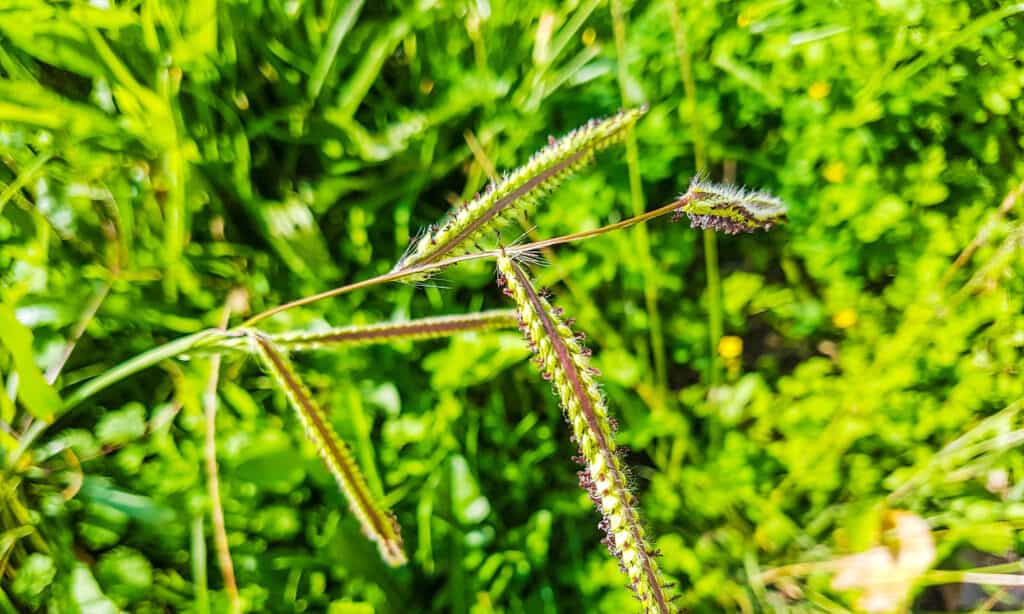
Also known as sticky heads, dallisgrass has a similar appearance to bluegrass but has larger green seed pods.
©iStock.com/arousa
Dallisgrass, also known as sticky heads, has a similar appearance to bluegrass but has green seed pods that are larger, higher, and thicker, causing them to droop. Dallisgrass doesn’t creep, as you’ll discover. Instead, over time, its clumped mat gets bigger. The best control method is to fully remove them from the ground, along with all underground rhizomes.
6. Purslane

Purslane can resist extreme heat and dry conditions.
©iStock.com/hongquang09
Summer annual broadleaf weed purslane, commonly known as portulaca, grows everywhere. Since it is succulent, this plant can resist extreme heat and dry conditions, which helps it survive in Houston’s humid environment. When you believe you’ve eradicated this glossy green, fleshy plant from your lawn, it returns stronger than ever and frequently collaborates with other common invaders. The plant serves as a ground cover and has the power to trample other vegetation in its path.
7. Chickweed

An annual plant, the chickweed is characterized by large, egg-shaped leaves with pointed ends.
©iStock.com/Stefan Rotter
Chickweed is a fairly prevalent weed in Texas and the rest of the United States. Chickweed will be more difficult to flourish in your environment if you grow a thick, healthy lawn. Since chickweed is an annual that produces white blooms from February to September, completely removing it from your lawn in one year reduces the likelihood that it will take over your lawn the following year. This plant is characterized by large, egg-shaped leaves with pointed ends.
8. Spotted Spurge
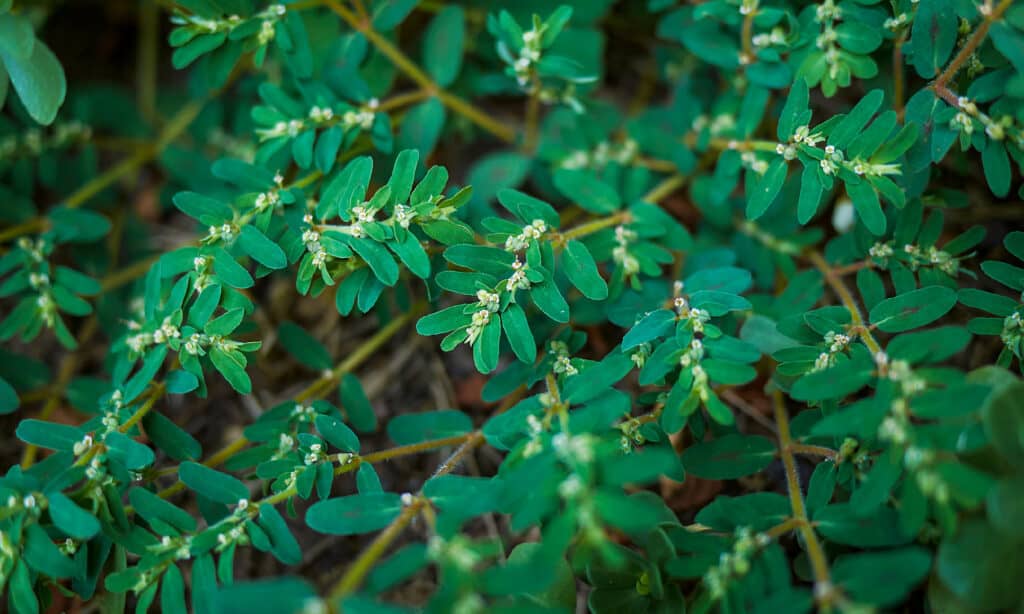
The spotted spurge weed grows slowly.
©iStock.com/seven75
Spotted spurge weeds can swiftly spread throughout a lawn or garden area and become a hazard. To stop this weed from spreading throughout the rest of the season, you must get rid of it before the seeds form. The dark green, mat-like, red-stemmed spotted spurge (Euphorbia maculata) grows close to the ground. This annual broadleaf plant with tiny, oval leaves grows slowly. The most distinguishing characteristic of this plant is a red dot frequently found in each leaf’s middle.
9. Wild Violets
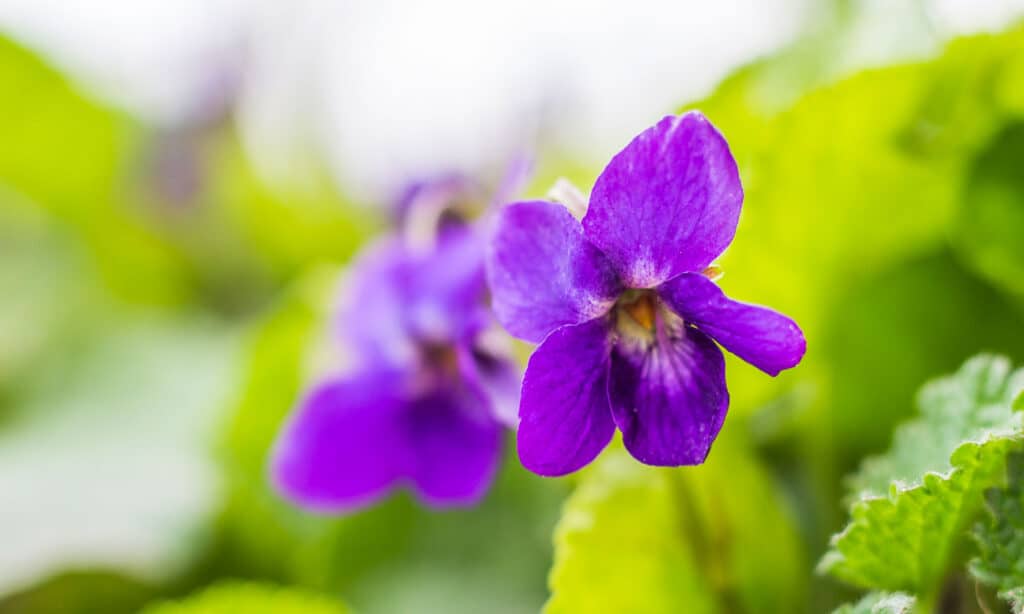
Wild violets have a history of creeping into flowerbeds and yards.
©iStock.com/Iurii Garmash
Although Texas is home to several native violet species, V. odorata, of European, Asian, and African provenance, was the violet of choice for most southern gardens. While violets might be attractive, their wild equivalent behaves like a tenacious weed that is challenging to eradicate. Additionally, they are hostile and intrusive, and they have a history of creeping into flowerbeds and yards. The roots and seeds of these plants are easily dispersed, and they return every year. Small, pansy-like wild violet blossoms range in color from blue-violet to lilac or white.
10. Henbit

Though henbit is regarded as a weed across the country, it offers important erosion control in many farmlands.
©iStock.com/hachiware
Henbit is an annual winter weed with greenish-purple stems, spring-blooming purple flowers, and egg-shaped leaves. The frustration of managing henbit weeds in your lawn throughout summer can be reduced by getting rid of these troublesome weeds before they flower in the spring. One of the most prevalent weeds in Central Texas, henbit (Lamium aplexicaule) is a member of the Lamiaceae or Mint family and was originally an escaped plant from Europe, Eurasia, and North Africa. Though it is regarded as a weed across the country, it offers important erosion control in many farmland sections of the southern U.S. According to several publications, this plant is weedy and has invasive traits.
11. Clover
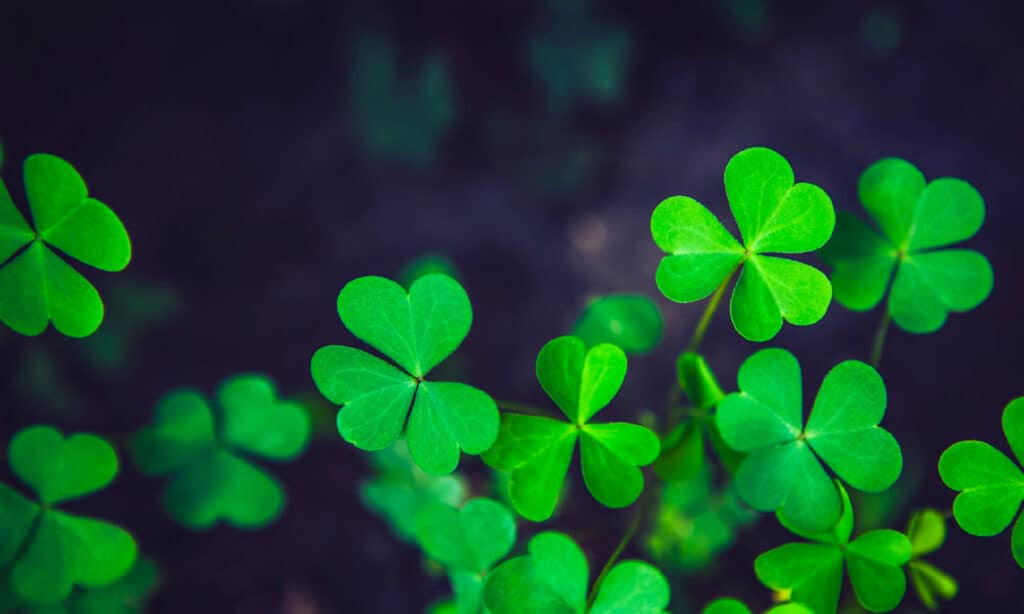
There are 42 species of prairie clovers in the United States.
©iStock.com/gadost
Because they are widely used by wildlife, prairie clovers (genus Dalea) are excellent markers of healthy grasslands and savannas in Texas. Of the 70 species of prairie clovers found in the U.S., Texas is home to 42 of them. Prairie clovers favor sparsely populated plains and savannas. However, clover is yet another unwelcome weed that can swiftly take over a whole lawn. It can make the lawn look untidy and choke out the grass, harming its health.
12. Creeping Charlie

Creeping Charlie can spread in three basic ways – its roots, seeds, and stems.
©iStock.com/MAsummerbreak
This swiftly spreading plant, which becomes challenging to get rid of once it has traction, is also known as “ground ivy.” This plant can spread in three basic ways: its roots, seeds, and stems. While it doesn’t directly hurt your turf grass, the way it grows tends to form “mats” that can rob your topsoil and root system of moisture and nutrients. Although difficult to eradicate, creeping Charlie is simple to avoid. Any remaining roots or stolons from an invasion will quickly develop into a brand-new plant that must be dealt with.
13. Thistle
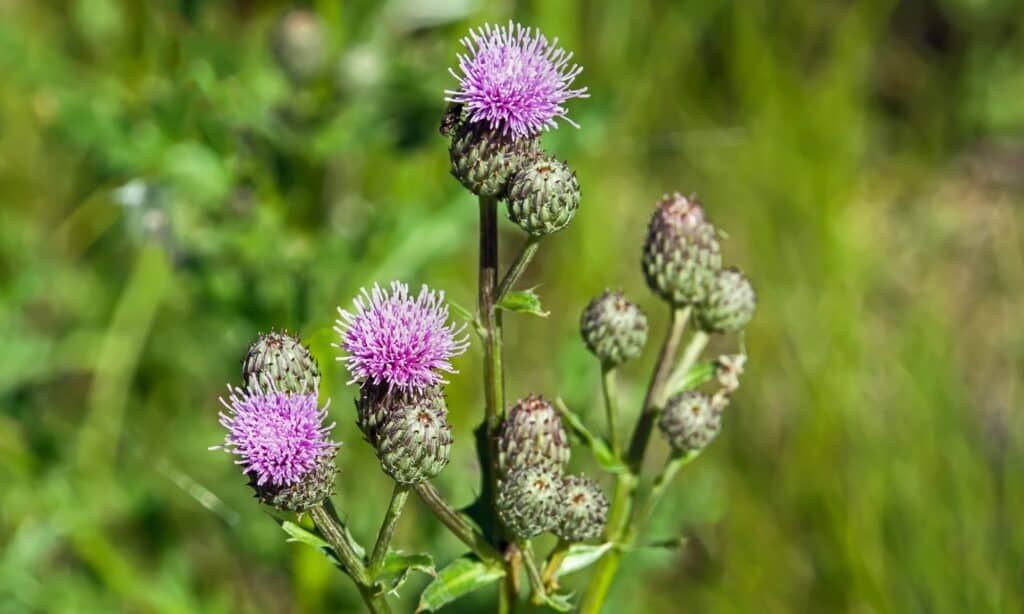
Completely removing the root system will stop thistles from returning every year.
©iStock.com/williamhc
Thistle can trick you when it first grows because it resembles dandelions until it produces those little spiky purple blooms. Any lawn with thistles is ugly, and their sharp leaves can be uncomfortable. The good news is that they may be easily removed by a professional and removing the complete root system will stop them from returning every year.
14. Quackgrass

Quackgrass is known as the bully of all weeds.
©Rasbak / CC BY-SA 3.0 – License
Since it resembles ryegrass and crabgrass, this one is difficult to distinguish. Its resilience is another trait that sets it apart from its relatives, in addition to its tufted growth style. Quackgrass, known as the “bully” of all weeds, drives out lawn grass and other weeds. It is a weed that is best left to expert lawn removal because it is difficult to contain due to its spread through the rhizomes. A healthy grass bed that is too dense to allow quackgrass to establish itself is the best deterrent.
15. Foxtail
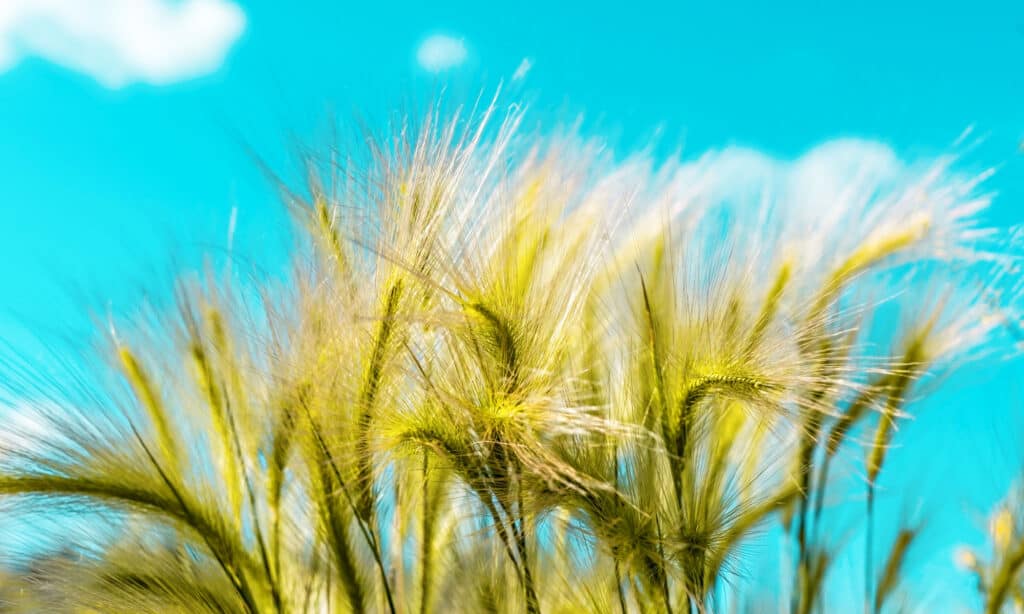
A foxtail seed embedded in your dog’s body might kill it.
©iStock.com/Elena Goosen
Foxtail is a weed that resembles grass. This weed quickly takes over unwary lawns and gardens due to its rapid growth and dense seed production. This plant has broad leaf blades and stems with three to ten inches long flower spikes. Foxtails are more dangerous than just irritating. A foxtail seed embedded in your dog’s body can create a dangerous infection since these hard seeds don’t degrade inside the body. If neglected, it may result in death.
16. Prostrate Knotweed
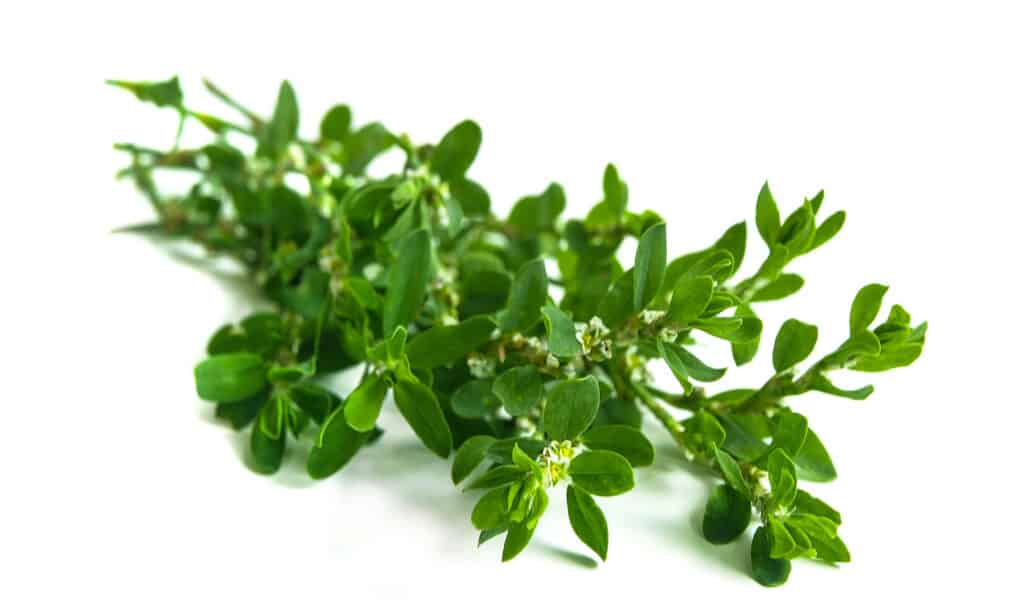
Growing yearly in fields and wastelands, the prostrate knotweed blooms from June to October with white flowers.
©iStock.com/al_ter
The prostrate knotweed, another typical weed in Texas, can grow as an annual in your yard or return as a perennial in unhealthful soil. It grows yearly in fields and wasteland and blooms from June to October with white flowers. It is common in many temperate-zone countries, appears native to Eurasia and North America, and has naturalized in temperate zones of the Southern Hemisphere. It is distinguished by multiple wiry, delicate stems that branch heavily and form mats.
Summary of 16 Weeds in Texas
| Species | |
|---|---|
| 1. | Dandelion |
| 2. | Crabgrass |
| 3. | Nutsedge |
| 4. | Bluegrass |
| 5. | Dallisgrass |
| 6. | Purslane |
| 7. | Chickweed |
| 8. | Spotted Surge |
| 9. | Wild Violets |
| 10. | Henbit |
| 11. | Clover |
| 12. | Creeping Charlie |
| 13. | Thistle |
| 14. | Quackgrass |
| 15. | Foxtail |
| 16. | Prostrate Knotweed |
What Yellow Weeds are in Texas?
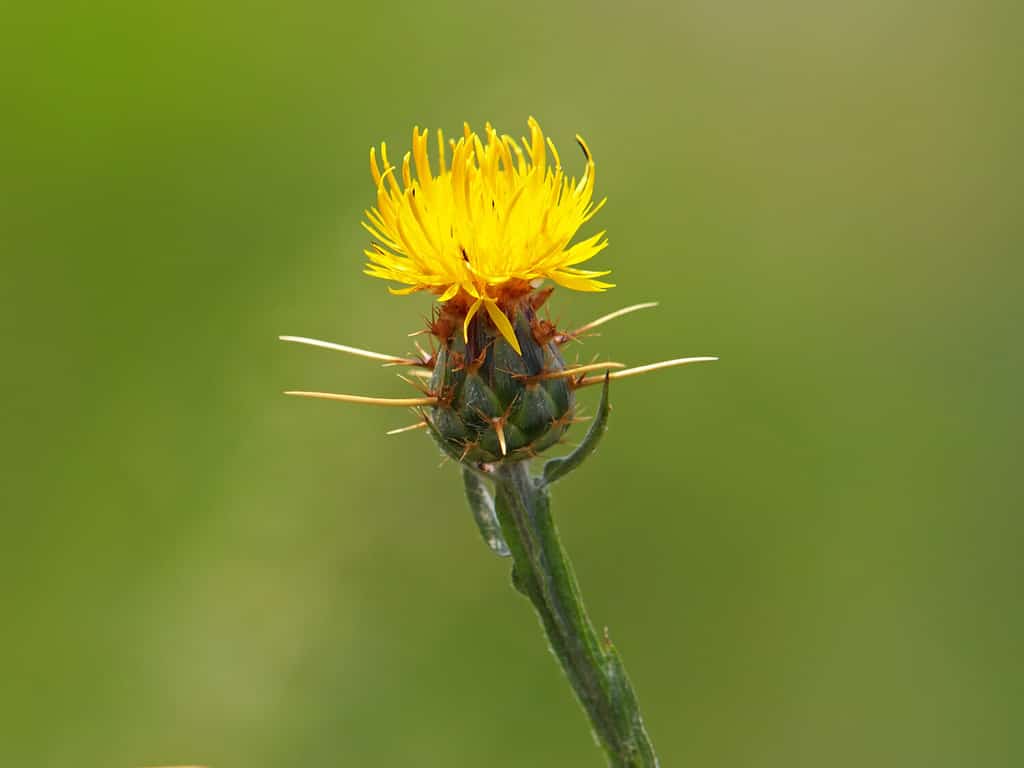
Yellow starthistle is a threat to not only horses but to the native environment as well.
©Emilio100/Shutterstock.com
The yellow plant found in Texas is actually an invasive weed called Yellow Starthistle (Centaurea solstitialis) and can grow to heights between two and six feet tall. The plant can appear to have a whitish color as a result of its cottony covering that is found on the leaves and stems. The yellow flowers, or blooms, resemble dandelions. There is no benefit to this plant for the animals in the area and it can cause more harm to them than good.
Yellow starthistle is a threat to not only horses but the environment as well. If eaten, it can be fatal to horses, causing chewing disease, and if untreated, can lead to death. It also affects native plants since it has a high-density growth rate which prevents other endemic plants from growing in the area.
The photo featured at the top of this post is © iStock.com/Elena Goosen
Thank you for reading! Have some feedback for us? Contact the AZ Animals editorial team.






